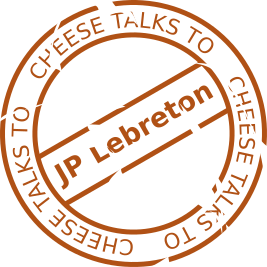
Over the past month, I've been siphoning time and thoughts away from developer, modder and Doom aficionado JP LeBreton.
In this interview, we chat about Doom, modding, NPCs in first person shooters, and JP's in-development mod Mr Friendly, which reframes Doom's cast of demonic monsters as friends who could use a hand with gathering ingredients for dinner, who need an intermediary to help avoid pressure on a strained relationship, or who just want someone to play hide and seek with.
To begin, could you tell us a little bit about yourself and your background in game development?
From my earliest years using a computer, I was drawn not just to games but to games that let you create, do stuff like editing levels. The first one might have been a C64 game called Mr Robot and his Robot Factory.
So I definitely got my start as a modder: Wolfenstein 3D, then Doom, then Quake, then Half-Life. At some point at art school I decided I was more interested in game design than what I'd arrived there to learn (computer animation, which was a somewhat more specific thing circa the late 90s) and got my first industry job in May of 2000. Level design was often a pretty generalist, art-design mix type position in those days. A couple years later I got interested in learning to program and started doing that on the side too. A series of weird coincidences got me on the team of a game that some considered "ground-breaking", and suddenly since then everyone thinks I know what I'm talking about.
id Software's 1993 FPS Doom is going to be a focal point for most of this discussion. How would you describe Doom, and what is it to you?
Doom wasn't the first "first person shooter" but it was the one that put a lot of ideas together in a form that felt significant and immediately compelling: it had extremely solid twitch gameplay, its technology pushed the envelope at a critical point in the evolution of desktop computing, its level design was complex and communicative, it had a ton of atmosphere for a 3D game in 1993, and it kicked off whole communities with regards to multiplayer and user-created mods.
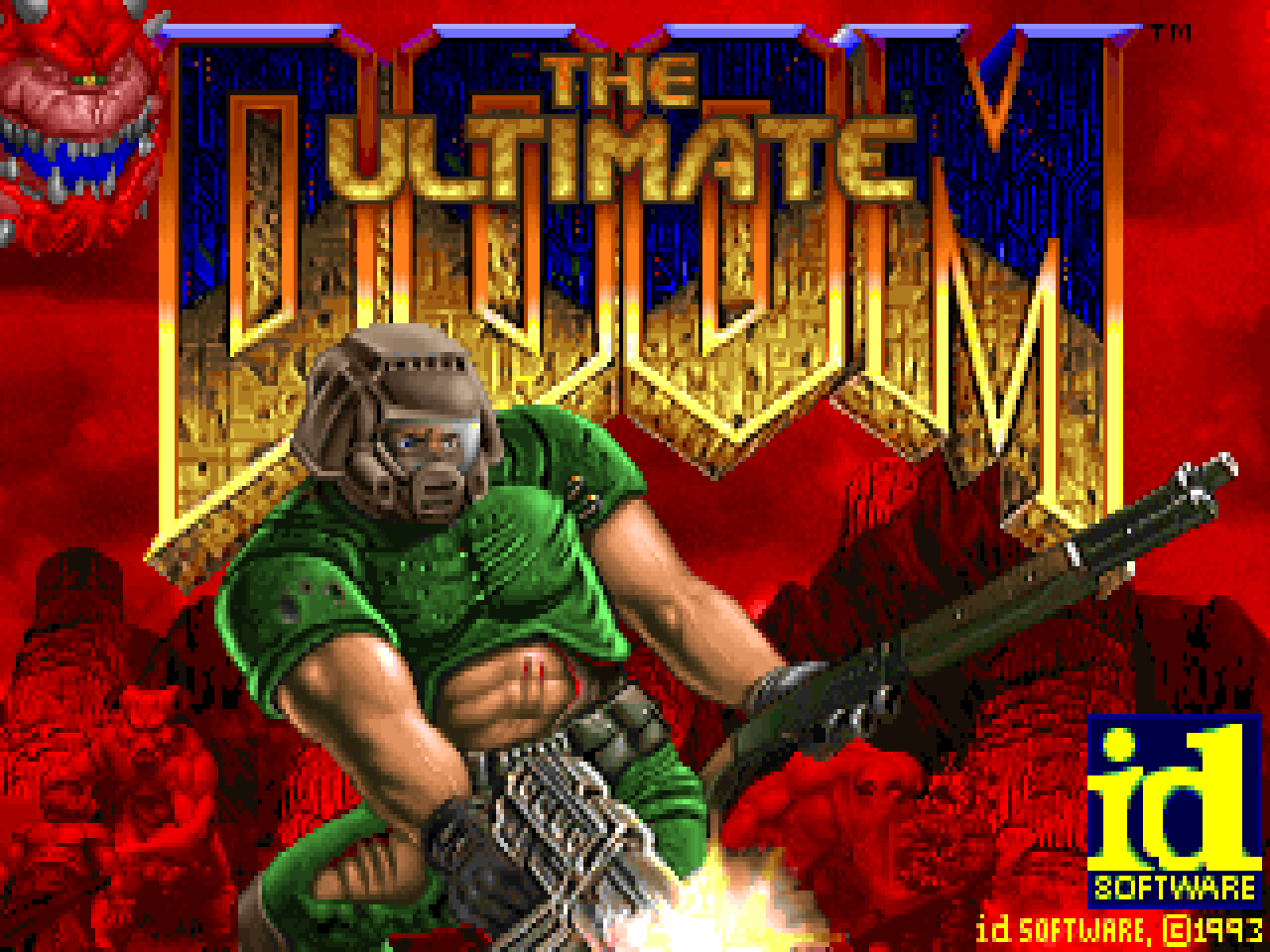
It also had a distinctive attitude which put it alongside games like Mortal Kombat and later grew into this monster that came to define "gamer culture": shockingly violent, edgy, gritty, technologically advanced, macho, marketed to adolescents rather than kids. By the end of the 90s this had become the status quo for games; aesthetically it almost ate up the medium. But compared to Doom's other qualities I don't think this aspect was so much a conscious creation as a byproduct of those other goals and the team that made it.
In the decades since, people have grappled with this legacy in pretty different ways. Even at the beginning of my professional career, my personal answers were already starting to take shape: games were an artistic medium; their future belonged to humanity and not just a few big companies; their possibilities were endless, spanning storytelling and sports and abstract art and systems thinking and more; games needed to grow along with the people who made and played them, beyond the power fantasy; the means of game creation needed to be democratized as much as possible, making games needed to become like being in a band or painting or dancing. And lastly and most significantly for me, that the career path I'd so eagerly jumped into right out of school was never going to fit me comfortably, that I'd need to wrestle the industry to get what I wanted out of it. So even a couple years in I was doing projects on the side, exploring weird ideas, building new skills, doing stuff they wouldn't let me do at the day job. And oddly enough, at multiple points in the past 20 years this has brought me back to modding. And Doom has always been there waiting for me, mutating in several different directions at any given time, far beyond the dreams of its creators. When something is so malleable, even a weirdo can carve out a home inside of it.
Are there any other games that you appreciate in similar ways?
There's a pool of a dozen or so games that I return to semi-regularly because I have a deep connection to them and also because they still show me new things. If I try to name em off now I'll forget several notable ones but the first Thief game has been back on my brain lately and it's definitely one. The way its atmosphere has staked out a permanent little spot in my brain is really something. Its audio design is still so strong, I think that's most of it. The worlds stay real in imagination even as the visuals fade.
What kind of influence, if any, do you feel your relationship with Doom has had on the work you have done with it?
At the end of 2009, I was finishing up Bioshock 2 at 2K Marin, and suddenly had a bit of free time. I'd kept up with the Doom community off and on over the years, playing random cool stuff that drifted across my radar. So I decided to start messing with a Doom level editor called Slade, sort of a super-duper version of the editors I'd messed with back in Doom's heyday, with a seamless 3D preview that made building stuff about 1000 times easier and more fun than those old tools.
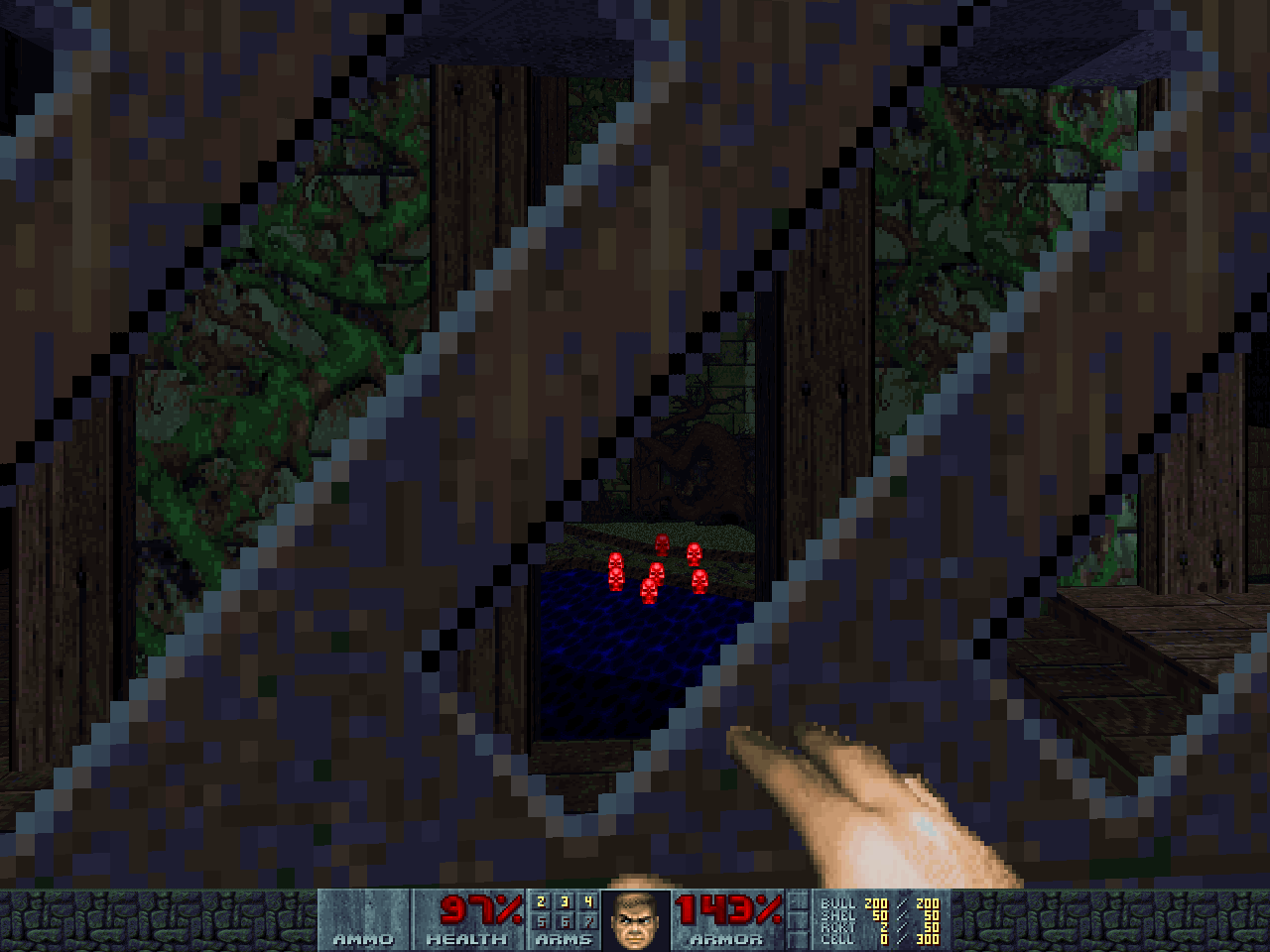
I didn't come into that with any grand visions for a level to make, so on a lark I started building the first room of a level I worked on for Bioshock 1, Arcadia. And I realized, this is primitive as hell but it's fun, and it isn't fundamentally different from what I'd been doing at Irrational or 2K Marin, and having just shipped these massive 8-figure budget projects with 100 people, Doom's severe constraints were pretty appealing. I figured I could actually ship a personal project with this, something I'd been struggling to do with my PyGame and ioQuake3 projects. So that's what I did, I released Arcadia Demade, a version of my Bio1 level rendered bizarrely into 1993-land. (Except that it wasn't strictly 1993-land, it was actually leaning on plenty of the fine work people had done with the tech since its open source release in the late 90s.) From that point, I always knew I could count on Doom if I wanted to build an explorable 3D space without a huge team.
Years later, I came back to Doom after a long period of thinking about the relationship between creators, technology, and tools. And that earlier realization, that Doom was something I could employ as a solo creator, felt more significant. By that point, I'd been playing Doom off and on for more than half my life. And what it meant to me had changed. I saw this game and many others threading through my life in all these strangely intimate ways: Doom was there at my first relationship, through the rise of my professional career, and through some difficult crises of my adult life. That was the genesis of Autobiographical Architecture. When you can modify a game (along with thousands of other people!) you become a part of it and it becomes part of you, part of human experience, in a way that's hard to fully describe.
For the past year or so, you've been streaming yourself playing through and discussing community made Doom content in a show called WAD Wednesdays. What inspired you to start this, and to grow it into the weekly event that it has become?
A few years before I started WAD Wednesdays, I built a twitter/tumblr bot called WADbot. Initially it just posted the names of random user-created levels from the Doom Wiki: names like "E3M5: The Ophidian Lair" and "MAP01: Didac's Revenge". Even these names, and the storytelling structure implied by the episode and map numbers, had a potent imaginative lure for me.
A while later, I found a blog called Stochastic Planet, which posts a random photo from somewhere on Earth every day. The possibilities of it enthralled me, and I almost immediately thought of doing that for virtual spaces - the tens of thousands of user-created levels in "the idgames archives", the big repository for community work stretching back to Doom's earliest days. It took some hackery but I did manage to get the bot working, posting "random places from the worlds of Doom every day", as the tumblr heading says.
Combing through WADbot's discoveries was very enjoyable. Sometimes if a level seemed particularly interesting, I'd follow the download link and try it out for a bit. As I became more comfortable streaming gameplay with a design commentary focus on twitch, I realized that I could do something that combined these ideas, and that maybe the same people who showed up to watch me play random stuff might enjoy that.
What are the most interesting things you've seen come out of WAD Wednesdays so far?
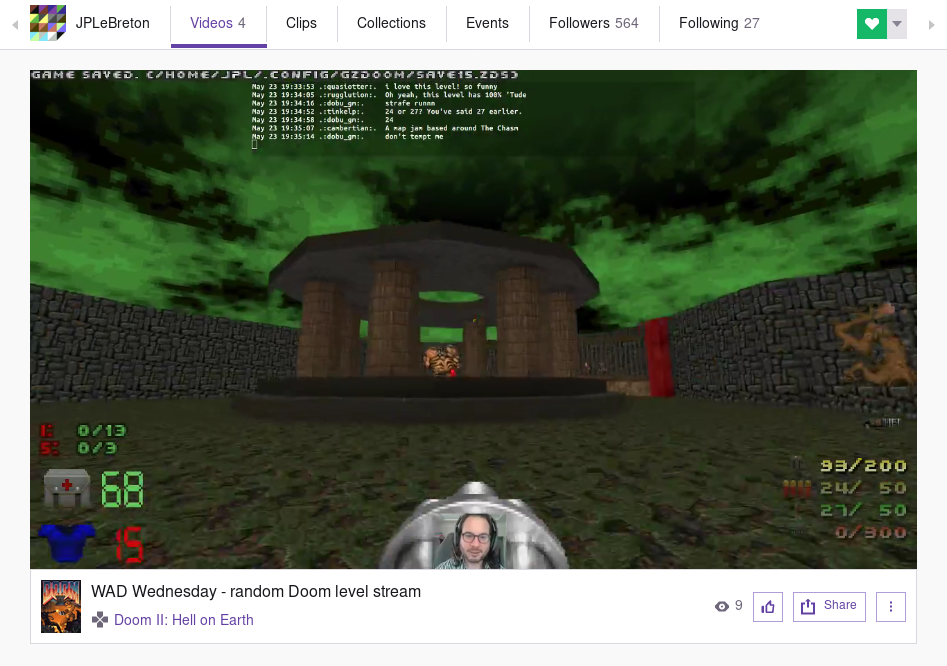
One is that a small community has developed on Discord full of interesting and thoughtful people, some of whom are doing cool Doom-related work of their own. I'd like to showcase this stuff in a future stream, maybe a "special non-random edition".
Besides that, I think there's been dozens of smaller discoveries within the randomly chosen maps themselves that are enjoyable and illuminating in many ways. Because Doom mods are a field where work is being done without any sort of profit motive, creators range over a wide range of inspirations, aesthetics, and creative values. Almost every map I play bears some kind of strange, personal touch - someone's house or office, a preference for particular textures or decorations, architectural tendencies, and so on.
What value do you see in preserving and curating community created content through archives like the /idgames database?
I think for anyone who considers games an artistic medium, it's a no-brainer. Even the most amateurish, low-effort work can teach us something and deserves not to be lost to time. Having a truly comprehensive archive gives you the total picture, which lets different voices curate or just dive in randomly like I do on WAD Wednesdays.
And for most older works, it's not like the costs of maintaining such an archive are significant - my local mirror of the idgames archive is about 19GB, and I can't imagine the IF Archive is any larger. An (illegal) archive of every SNES and Mega Drive etc game ever is about 2.5GB. That's so much important history.
And for the most part, companies can't be trusted to honor and preserve the majority of it. Sure there are re-releases and remasters of the most beloved stuff, the stuff with uncomplicated copyright situations. But all the forgotten stuff has value as well, it's waiting for the day it's rediscovered to yield new understanding. Most of the people who designed the first digital games are still alive, so it's a living tradition. In the next few decades as the first generation passes away we'll need to consciously act to keep it a living tradition. But the alternative is a world that constantly forgets its history and I think that world is immensely poorer.
What do you see as the role(s) of non-player characters (NPCs) in vanilla Doom?
As I said in my old Doom piece from 2010, Doom has a very diverse monster bestiary compared to most other games. The mix of fast and slow, melee and ranged, flying and ground-based, very low hit points and "a walking door", varying attack patterns; these things all give you a huge range of ingredients to work with when designing combat encounters, and unlike most FPS Doom is a game where having a large number of them doesn't just turn into noise.

Because each monster has its own "personality" on a purely mechanical level, many players develop a different sense of "personality" for each on a non-mechanical level. I've joked that the monsters feel like old friends to me[1]. Once upon a time Doom's violence was the most shocking and realistic stuff out there but at this point it feels more like a cartoon, albeit a gory one a la Itchy & Scratchy. I find that cartooniness a useful alternative to the utterly grim suffering of most modern FPS, and it informed some of the world design in Mr Friendly, the idea that the monsters "die" in some Looney Tunes kind of way but "get better" or are brought back to life and this is just a daily routine for them.
How do you feel these kinds of roles have changed over time both across id's lineage of games and the broader FPS genre?
As the FPS has branched out in a dozen different directions, so has enemy design. Thief's enemies aren't defined by their offensive capabilities and behaviors nearly as much as by their idle and search behaviors, because that's by far what the player spends the most time tangling with. They're not targets they're guys with crappy security jobs. Serious Sam's enemies go even further down the dirt-simple arcadey path than Doom and mostly just run towards you. Any game where taking cover matters - Half-Life 1 or Halo, say - the player learns the flow of a given enemy's "state machine" - what makes them go from attacking to fleeing to hiding to flanking, etc. Each NPC becomes a little system in its own right, and the player is surfing or exploiting or avoiding the chaos.
That's all on the mechanical side. Your next question touches on what having "enemies" means to the non-mechanical aspects of games, so I'll continue there.
Are there any areas that you feel remain unexplored or under explored so far as NPC roles are concerned?
For a while, game NPCs were just enemy monsters or static quest-posts. Then there was a huge movement to prove they could also be real story characters, and I think games have conclusively proven that that can be compelling. The unexplored areas are the ones where we still have no model for. A lot of those lie on the boundary zones between pure authorship and pure simulation. Many "interactive storytelling" approaches have impractical expectations for what can be simulated, or even what the best starting point is: do you generate a plot and spawn characters to act it out like improv, do you simulate characters and let a plot (in retrospect) emerge from the chaos a la Dwarf Fortress, do you give characters a reactive role and make the world a primary source of stimuli? I honestly don't know which approaches are best, and all anyone can do is take stabs at it. But I think that's where the under explored stuff lies. Authored stories are here to stay, people immediately "get" them and if you "have a story to tell", just use those proven techniques. If you want to see if there are other possibilities lurking in weirder corners of our medium, go forth with my blessing.
How would you describe player's immediate goals and broader objectives in Doom?
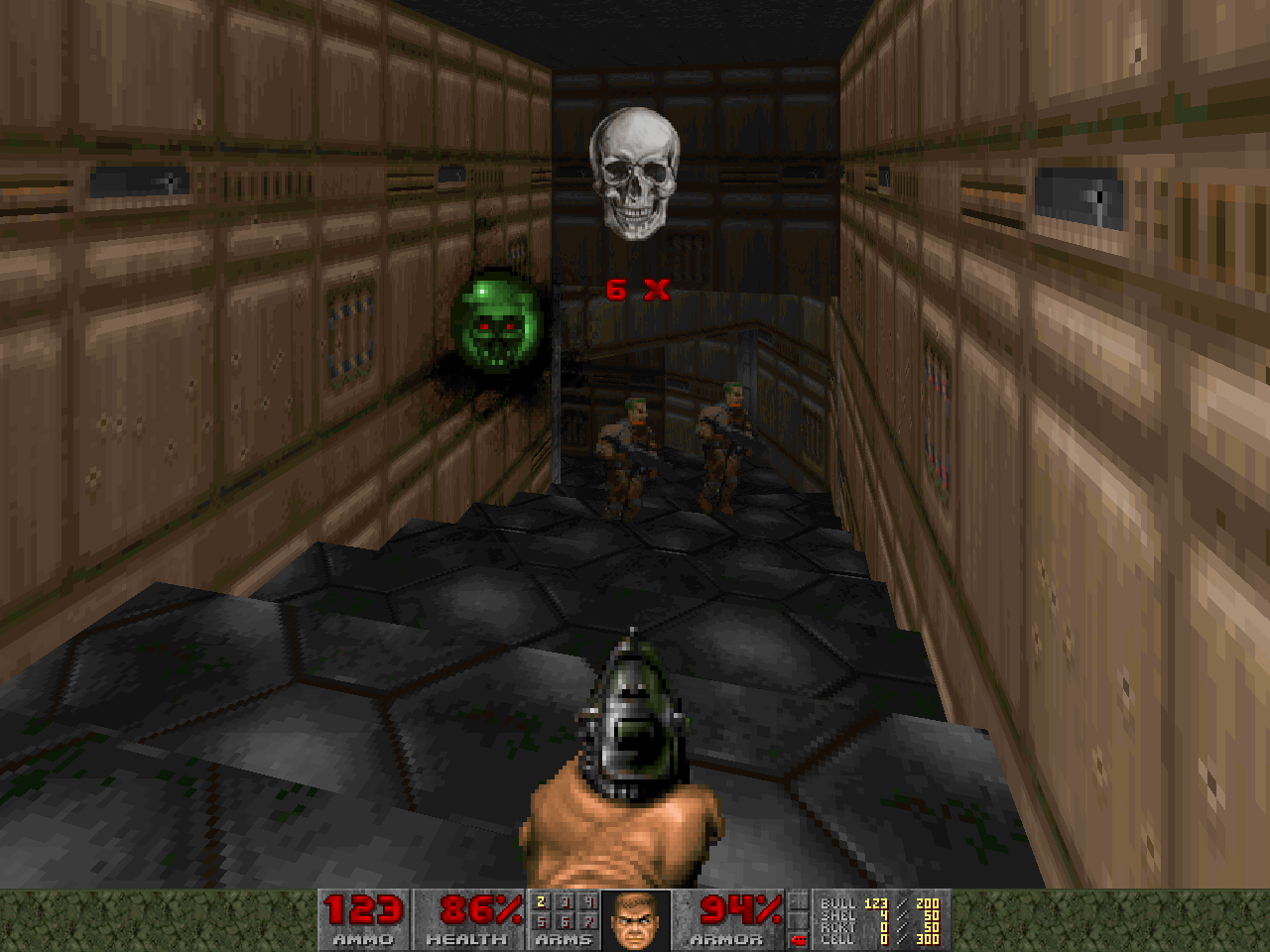
It's famously simple and direct: stay alive, find the exit to the next level, when you reach the last level, kill the boss monster(s). The most complex it gets is finding color-coded keys to unlock doors.
That's the popular account at least. But honestly, Doom levels can get extremely complicated, especially the ones made for "limit-removing ports" which can stretch on for miles, and thread that relatively simple key-based progression through tons of different kinds of intricate environments, navigation and switch puzzles, a vast playbook of combat encounters, and cool scripting stuff. If you spell it out in simple walkthrough steps, Doom isn't fundamentally less complicated than Bioshock. It's the levels that create much of the interesting complexity.
How do you feel player objectives in FPS games have changed over time?
I feel like Half-Life was the big watershed that forever changed the industry conversation around that - the older order of "find the key, escape the maze" that Wolf3D and Doom codified. Half-Life used in-world scripting to make it really feel like those objectives were arising from the world itself and what was happening in it. We saw glimmers of that earlier with System Shock and Marathon, but their story-based objectives were taking a page from the much older tradition of CRPG and even tabletop design. In one sense HL1 was the merging of all those traditions, the maze design and the RPG module and the "interactive movie". In another sense it was simply where games were headed; Quake 2 and Unreal came out earlier that same year, and Thief came out only two weeks after HL1.
Things have continuously expanded and diversified since then, of course, but as far as player objectives and how they're presented, I think 1998 was the point where we reached a kind of paradigmatic homeostasis.
Many of your Doom mods focus on providing alternate play within existing maps. What are your motivations and inspirations for these kinds of projects?
After all these years level design is still kind of the innermost home territory for my game dev brain, I can always fall back to thinking in terms of building out space to express things. So turning that on its head, where you take the space as fixed and see what kinds of rule changes make that space play differently-interestingly, is a very appealing way of going against the grain. It's the tinkering instinct playing against the more dreamlike mindset of building spaces.
How much of these mods' identities comes from something that's been created by you, and how much comes from things that were always there, but often obscured behind Doom's original gameplay?
It's ambiguous, and kinda is for every mod that isn't a "total conversion" (ie replacing every bit of audiovisual content, effectively making a new game). In a sense Mr Friendly is me "reacting to" Doom, picking it apart, injecting my own themes, doing a kind of Mystery Science Theater 3000 type commentary over it.
From your "game tourism" initiative through to to your most recent Doom mods, reframing players' immediate goals away from killing NPCs feels like something of a recurring element in your modding work. Is this something you have consciously pursued, or do you feel that it's the emergent result of exploring ideas that happen to lie in less-violent realms?
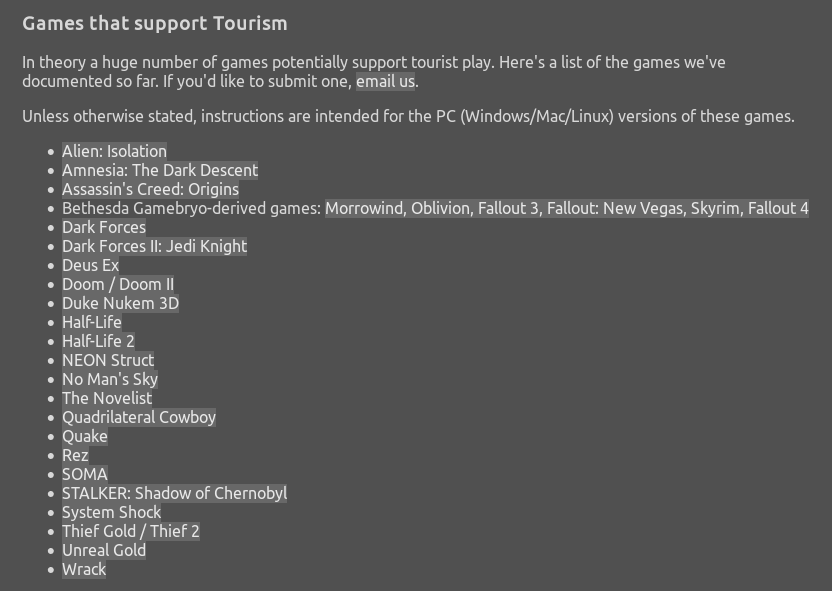
There's a few reasons. One is something I wrote 10 years ago, in which I argued that games are always going to feel like a limited medium if we can't grow the mechanics beyond dealing damage and killing. Mechanics form much of the building blocks of a game's expressive capabilities, and if we freeze mechanics at 2005, we're not going anywhere too interesting no matter how good a theme or story we can wrap it in. Fortunately, from about 2008 onward, games exploded with independent work that in my opinion wrestled the destiny of the medium away from the exclusive possession of AAA games. That renaissance, of games being "about" more things, I was calling for began to happen very shortly after I wrote that. It manifested differently; I thought it'd be mechanics-focused and fiction played a much bigger role. But that's fine. I wanted the medium to thrive more than I wanted my personal design aesthetic at the time to "win".
The second big reason is that, like I said earlier, I think games need to grow with us. What excites me as a 30-something man frequently isn't what excited me as a 13 year old kid. And specifically in the big projects I've been part of... there are many things in the Bioshock games that I no longer stand by as a creative or political person, I actually deeply regret certain parts of those games' legacy. So in a weird way, the Game Tourism stuff is an attempt to reclaim the parts of the medium I love from that swamp of consumerist nastiness and unexamined dogmas. It's saying, look. This level here, this was a few weeks or months or years of someone's life to build. Sure it was built to be a murderworld, but what does it become if you remove the murder? It's not nothing. It is still a space, a place to exist in. It has a soul. Listen to what it is saying.
Has experiencing familiar games through a "tourism" lens lead you to discover anything new about them?
Every room you visit where the murder has been removed is a little discovery of its own, potentially. It's been a lot of small moments of reflection, drinking in atmosphere, appreciating random creative decisions. You can usually do these things even with the vanilla game but I started doing the tourism stuff specifically to maximize these experiences.
What kind of responses/outcomes have you seen from your list of tourism-friendly games/mods?
People have appreciated it, I semi-regularly see people link it - Rock Paper Shotgun's writeup of Unreal's 20th anniversary linked my Unreal tourism mod. The usual responses range from "Oh, that's neat" to "gosh, I've been looking for something like this for a long time!" I fortunately haven't gotten any gamer traditionalists on my case. I think most of them know they lost, games are so many different things now and tourism isn't even that radical a departure. So it's all been for the good.
Mr Friendly has a very specific style and tone. What inspirations are you drawing upon, and what do you hope to evoke with that?
Animal Crossing was a pretty obvious reference point; I wanted to transform Doom levels into social spaces, because AC's sense of social space doesn't have much to do with spatial layouts anyway. AC apparently started development at Nintendo as an RPG, they gradually stripped out all the actual dungeon crawling. You still do quests in that game but they're presented as building a relationship with these persistent characters. That makes them less disposable, more like real characters. If I ever do a big 2.0 revamp of Mr Friendly that's something I'd want to explore: characters carrying over from one level to the next, they recognize you from earlier and your relationship to them deepens somehow.

I started work on the mod using lots of assets ripped from other games - a modified version of the voodoo shopping list from Monkey Island 2 for the quest screen icon, for example - as a placeholder, but then I started getting into an aesthetic groove with that stuff, thinking about how a given reference to a specific game was a statement in itself. And also I didn't have the patience to do much original pixel art myself, which would have turned out mediocre anyway as my art skills are pitifully atrophied. So the high density of low-key "samples" became a conscious thing. I thought of The Avalanches first album supposedly having 3,500 samples on it. When you sample like that, it builds up a texture of its own, you're creating a collage.
I also really wanted to copy that thing the Katamari games did, where you have that gallery of every single object you've ever rolled up, each with a short funny description that's just a perfect pure droplet of that game's sense of humor. Having a comment on everything in the world recontextualizes it pretty thoroughly. I built this whole alternate scaffolding of meaning around this older beloved work, I think that's a fascinating process. Check out Brad Neely's "Wizard People, Dear Reader" for this if you haven't, it was hugely influential on me going back a decade.
What led you to the kind of NPC interaction we see in Mr. Friendly?
Many years ago something reminded me of the 1994 Edge review of Doom, the old "if only you could talk to the monsters, forge alliances, now that would be interesting". And it's become a bit infamous as an example of critics missing the mark, being a little too cool for school. But I always thought, that'd actually be a great joke. Take this thing that was originally a hyper violent tech bonanza and make it about talking to monsters. I didn't really know where to take it from there and forgot about it for several years.
A year or so ago, I started learning the ZScript scripting language that had just been added to GZDoom. And it opened up so many possibilities, and gave me all kinds of ideas for mods. I wanted to make a "variety mod" where lots of different weird little things about the game changed on every level. The old "talk to the monsters" idea resurfaced, and at the beginning of this year it crystallized in my head as an implementable thing so I started making it.
To be very clear, many many mods before Mr Friendly have done the "friendly monster you can talk to" gag before. But I wanted to make that gag the core part of the premise, and see where that led.
Now that you've explored this to a degree, what do you feel to be the most interesting and evocative aspects of your take on that premise?

I've enjoyed writing things that stretch our assumptions about Doom's world, and about game worlds more generally. The monsters clearly have some awareness that their world connects Earth and Hell, but also places that seem like they're from other games, and/or they joke about knowing they're characters in a game (but hopefully not in a way that invalidates or deflates).
The Wandering Demon character is sometimes a proxy for my own thoughts about the world, or just the kinds of thoughts I imagine travelers would have in these worlds.
For a possible-someday-2.0 version, I'd definitely like to do more with persistence, have monsters show up in later levels and remember your prior interactions, track the monsters in a more sim-like way so they can have more distinct identities and histories. But to be clear once I release a non-beta version of it, which won't be significantly different from what's on itch.io now, I have no idea when I'll return to the mod next.
The Mr. Friendly mod carries with it a degree of characterisation and lore that gives a strong sense of in-fiction colloqualism, particularly in its presentation of monster dialogue and environmental doodad descriptions. What inspirations did you draw on for these, and how did you settle on the tone they convey?
I was drawing mainly from my own mental map of Doom and my own sense of humor, but the way senses of humor work is they're often a giant katamari of all this other stuff you find funny. Some of it is referential humor, some of it is just playing with words, some of it is that sort of wry recontextualization that say the Monkey Island games did well.
There are a few different voices present within the writing, as well:
- The monsters all speak in a fairly contemporary, informal sort of twitter-like patter. All the non-quest chat lines are just in a big pile and the mod chooses one per monster per level, and there's no persistence or context I can use to build a more complex character so it's all one-liners.
- When a monster has a quest for you, there's a chance to go a bit deeper since each quest has multiple stages of writing. So in the quest intro line I could establish that a character has one motive, then once the quest is completed, they reveal a humorous ulterior motive. Or they have a particular personality trait, like the "snooty collector" who shows up in some Lost Item quests, that informs the tone of all the lines in a quest chain.
- The object names and descriptions are the voice of Mr Friendly himself, which is somewhat different from the monsters. I wanted to use a light touch in terms of spelling out what kind of character Mr Friendly is, given that my means of delivering that character are scant - the object names and descriptions, and the end-of-chapter text, mainly.
- Lastly there's the Wandering Demon, which your next question is about so I'll answer there.
The Wandering Demon is a character presented through journal pages and the murmurings of other NPCs, and who comes across as poetic and reflective in contrast to everyone else you interact with, whose attention is typically occupied by the immediacy of their troubles or thoughts. What lead you to include an inferred character like her in the mod?
Early on I knew that having some sort of story bits lying around in the world would be a cool opportunity to do different stuff. And later as I was coming up with quest types, a "collect 3 Blahs" was pretty obvious and easy and I figured the Blahs might as well be something slightly more interesting than a red coin.

Then I started thinking about what kind of character would leave these notes lying around, in potentially any level. And I figured it must be a person who journeys just for the sake of journeying, which automatically implies something about their viewpoint. And I realized there was some resonance with my perspective as the author of all this; I've spent a lot of my life wandering around virtual spaces, and some of the thoughts I've had along that journey would probably be interesting to put into this fiction.
There's also a bit of mystery to the character; you're following in her footsteps in a sense, so the question of where she was going and why, and what she was really like, are nice little carrots to perpetually dangle before players who find that sort of thing interesting.
If you could hope that players took one thing away from playing Mr. Friendly, what would it be?
I partly answered this in [a previous question]: "What does [a game space] become if you remove the murder? It's not nothing. It is still a space, a place to exist in. It has a soul. Listen to what it is saying."
Another player experience goal I had, and I have no idea if I succeeded, is to create something that felt okay to play at the end of a long day's work. As I alluded to in my interview for the Kotaku writeup last month, the world is a pretty bruising place to live in right now for a lot of people, and I wanted to make something that actively tries to cultivate a sort of coziness - see [Cozy Games on Lost Garden] for some great thinking on what "coziness" means in games - and that gives players something positive and healing, and do that on the skeleton of something that's long been considered macho, violent, grim and dark. Not everything like that can be defanged and made into something kind and gentle but I wanted to try with something that I already knew and loved.
What kind of responses has Mr Friendly received so far in its beta state?
I've seen entirely good responses, people "get" what it was trying to do.
It was a real kick seeing one of the Back To Saturn X mappers - Tarnsman I think? - streaming one of his levels with Mr Friendly. It was the first public release from 4/21 so there was bugs but he was just rollin' with em, and pointing out the finer points of his level design along the way. That was nice, I haven't had too many connections with the, uh, mainstream Doom community over the years I guess.
What does your development environment for Doom modding (and game development in general) look like?
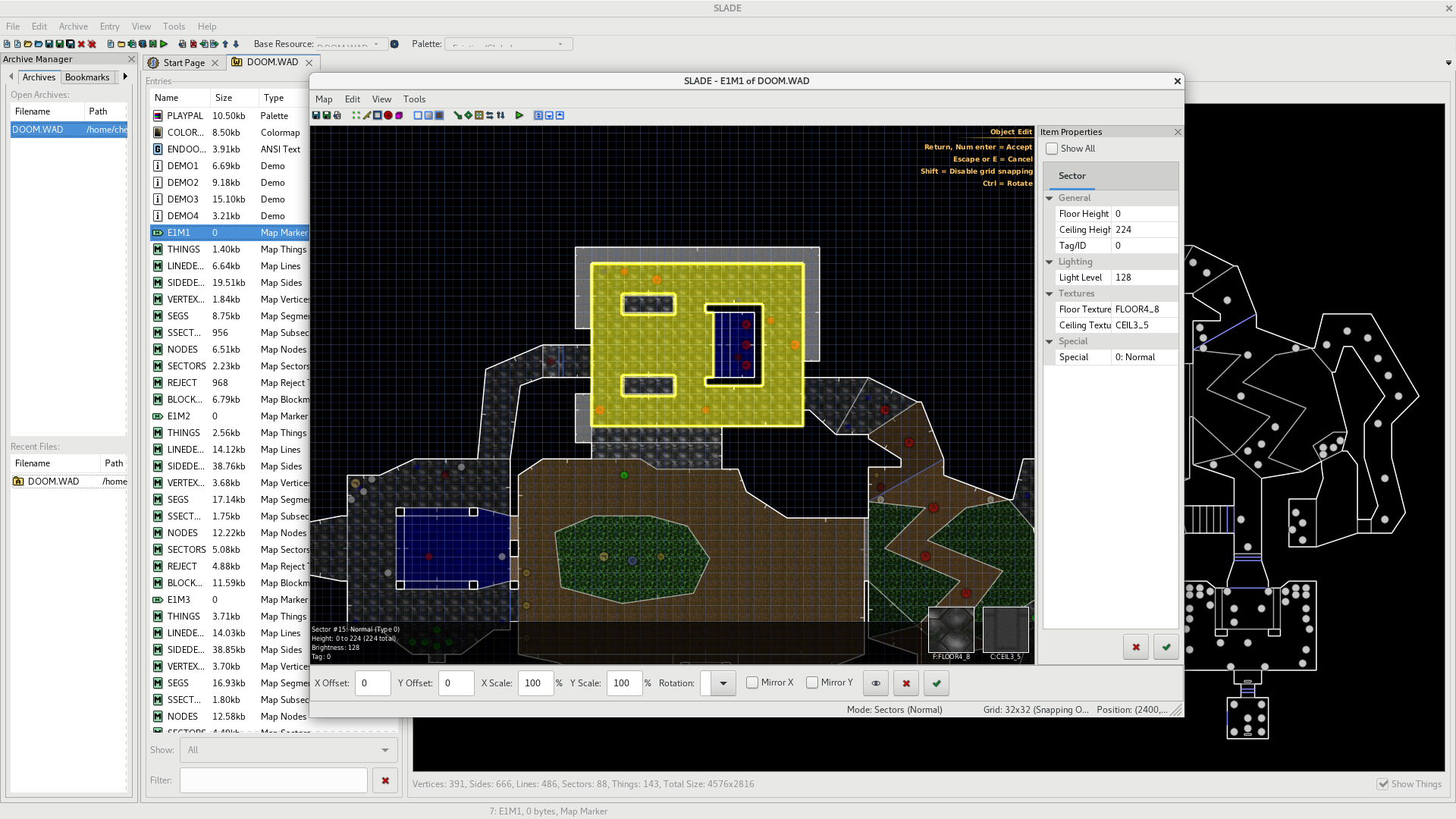
Linux is my main "getting stuff done" OS, I dual boot Windows but only for the occasional Win-exclusive Steam game I get into. On desktop I run Antergos, which is Arch with a nice GUI installer; on my laptop I run elementaryOS because I wanted to have an Ubuntu-derivative to test on too.
GZDoom is the version of the Doom engine I do all my Doom work in, it's by far the most actively developed and rapidly evolving "source port" out there. I usually run from the latest git master branch.
SLADE is the program I use to edit levels and various other bits of Doom data. It's a real swiss army knife of a program, and it's cross-platform. I really appreciate that it exists.
I use Emacs to edit all my code and text-based files, though I run vim from the terminal to edit things like Mercurial (my choice for version control; I find git too confusing) changelogs. I use Midnight Commander to manage files, OBS Studio to stream. And for plundering assets from old games there are innumerable little exporter type tools people have made, many of which are on github - you can browse my "starred projects" to see some of em. Others are ancient DOS executables that are only available for download on some obscure old mod page.
What do you feel are the most significant capabilities and limitations of the Doom engine for the kind of mods you create?
The weird and limited way you have to build spaces in Doom is also partly a significant capability: you can only fiddle with your 3D geo so much. Being able to represent a level almost entirely from a top-down view simplifies your mental model as a creator, it also means fewer clicks than almost any other engine to make a room, a hallway, a doorway. And the general lower fidelity helps this: fewer pixels to sweat, fewer decisions to make means each decision becomes more important to the finished piece. That's the space I always want to be working in.

On the gameplay side, GZDoom has this very data-driven (though not in the super modern engine design sense) way of defining new monsters, new objects, new weapons. And ZScript turned that data definition language into a full-on scripting language which exploded the possibilities in every direction. To me it feels very much like UnrealScript circa 2000-2002, which was what I did my first real coding with. Having a game that you already enjoy playing in its vanilla form and a massive palette with which to add to it is a very exciting feeling. Ideas just tumble out, some of the cooler mods I've released like Keymaster and Green Demon were just a matter of having an idea, knocking it together in a few hours, then having a fully playable thing within a couple days' work. You don't get that with Unity or Unreal. Mods are important and I hope they get another golden age soon.
As far as tooling limitations, GZDoom is not a bed of roses. Very little in the engine is runtime editable, so you have to reload the engine to see any of your changes. A rapid turnaround time for reloading changes is nice but it's far better to have as much as possible live-update. And ideally, in my opinion, you have the editor built into the engine itself, and you can do much of what you need from there without having to jump around to outside programs. Playscii was my first big attempt to build a little environment like that, something you can *think* in once you learn it well enough, like a musical instrument. Miles to go but that's always where I'm trying to get to.
What advice would you give someone wanting to learn more about Doom mapping and modding?
First thing to know is there's a large and very active community! And most but not all of the people in it are friendly and helpful. I lurk on the ZDoom forums and the ZDoom Discord when I need help with a technical matter. I think the Doomworld forums are more mapper-centric. There are some pretty good tutorial videos on Youtube. The ZDoom wiki documents a lot of the extra stuff ZDoom can do, but not all. The recent ZScript stuff is fairly underdocumented but there have been a few good efforts to change that, eg [marrub--'s zscript-doc].
One thing that's super nice about Doom is that there are almost no intermediate file formats, everything that ships with a mod you can crack open in an editor and learn its secrets.
Over and above learning the tools and tech, I'd say find a group of like-minded creators, support each other and share work and ideas. Doom isn't a monolithic scene, there's a whole lot of sub-scenes of related works and inspirations.
You mentioned Doom's source release earlier. id had a history of releasing source code for their games' engines under the GPL as part of end-of-life strategies. What do you think are the most important legacies of this, both for games like Doom and for the "craft" of game development?
I appreciate that there are technical and legal barriers to doing so, but I think open sourcing older games should be the rule rather than the exception. I think lots of bigger companies are still so ignorant about open source that they think it means giving their game away for free, which is silly given that Doom Classic Complete still regularly shows up in Steam/GoG sales. There comes a point where an old game becomes more valuable as an open source project than as a sad moldy old DOSBox-packaged thing on a digital store shelf. So preservation is part of it, but I see respect for the medium and craft of game development as equally significant, and I think source releases are a great way to honor that. The worst case scenario is that you go through the trouble to do a source release and nobody forks it on Github or whatever. But if you release it then it's up there forever, and someone in 2032 might pluck it off the shelf and do something neat with it. That's what a living medium is, not a warehouse full of discs suffocated in their boxes.
Where do you see yourself in two years' time?
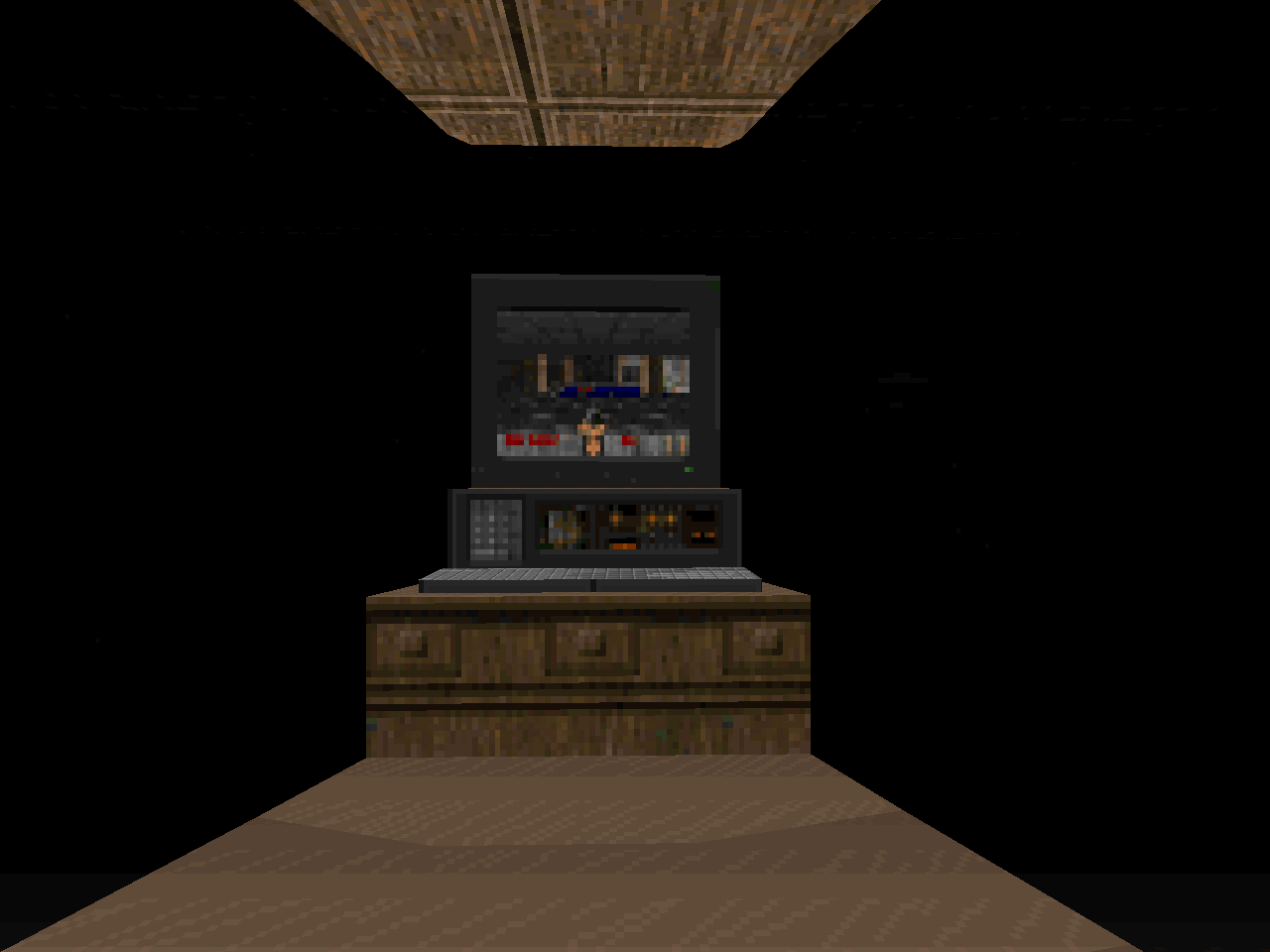
Alive, hopefully.
Seriously I have no idea. All my friends who were doing independent development either got day jobs or moved out to the desert. I'll always want to do my own projects but I wasn't a golden ticket winner in 2010-2013 so... yeah.
To wrap things up, what is your favourite game (if it's Doom, maybe mention that and then talk about your second favourite game)?
I'm real bad at picking favorites, any answer I give will be entirely of-the-moment. So here's some recent ones: Thief Gold, Starflight, Jet Set Radio Future, N++.
Nemoder: If you were designing a Psychonauts 2 level for the mind of Cheeseness what would it look like?*
I always imagine the minds of game developers are populated with fragments of the games they've worked on, just because mine sure as heck is, so maybe that's what I imagine Cheese's brain is like. Boy there are some great games in there! What good taste this man has. So it's very tastefully appointed, very chill. Not a lot of combat in the level, just a friendly exploration experience with a lot of neat things to do and see.
Bidiot Bales: In The Cave, what was behind the decision to include the unchanging levels in between the character specific levels, as it seemed to turn a lot of people off doing multiple replays?*
[dusts off 2012 cobwebs] Ah yeah, the "spine bubbles" - the Gold Mine, the Zoo, the Island, right? I think we underestimated the time and energy of replaying those on later playthroughs, or maybe we didn't know how many people would be doing replays? We definitely wanted to make them quicker to play through, the Gold Mine in particular kills me. There's one or two places where even an extra "rally point" (easy-to-add) invisible trigger that makes your team run in to catch up with you) would have streamlined things nicely. Stuff like that keeps me up at night sometimes!
SuperArjunaButt: After the indie wave has tried the immersive sim genre with titles like Neon Struct, what unexplored directions do you think would be interesting for them to go in?*
Indie games have definitely proven that you can build a small lightly-sim'd world, let some characters live in it, and make a cool story about the player uncovering what happened there. So that's what I'd call an "explored" direction at this point. Simulation-wise I think there are more unexplored areas but they require some design spelunking and don't give you that instant critical interest / comprehension the way a story does.
Also characters can be harder with indie budgets so you have to get clever: turn them into books, turn them into ghosts, make them unable to speak, make them entirely disembodied voices, etc.
One thing I'd like to see immersive sims as a whole push on is more mutable environments, eg players using tools to make changes to the world that go multiple steps further than setting a thing on fire, opening a lock with a key, turning out the lights. In general with lower visual fidelity you can make more things dynamic, so I think there's particularly an opportunity there for smaller teams.
Bidiot Bales: Have you played 2016 Doom, and if so how do you feel it compares to the original game?*
I haven't played it yet! It'll happen, for a while I didn't have a video card that could run it but that excuse has run out. As a mechanic the glory kill thing seems fine but I gotta say it turned me way off on initial impressions, I just don't care about the Brutal Doom appeal these days, it's just kinda sad.
Hodge: When playing old Doom levels for WAD Wednesday, have you ever seen design ideas that you miss in modern games?*
Modern games are so craft-aware, everyone goes to GDC and learns the Right Way to design a game. That's not all bad but I think it's probably concentrated our creative attention around a few specific definitions of craft, and there are many more ways to make compelling things than are dreamt of in that philosophy. Playing random old sometimes-crummy WADs from the mid 90s is a weirdly fresh breath of air in that regard. Every designer was figuring out their own style, copying stuff but in their own weird ways, often with less self-awareness. It feels like a local music scene, people aware of each other but doing their own thing. And specifically around level design, I don't see that much outside of Doom.
I really hope another game comes along that 1) lots of people get obsessed with, 2) has a very open and flexible way to make 3D levels for, 3) develops a community around distributing and engaging with that work. I think level design has become a little too locked up in industry practice and too little in the amateur space which is where so many designers of my generation came up[2].

A note from Cheese
Thanks for reading, and a very big thank-you to JP for sharing his time and thoughts. This is the first proper Cheese Talks interview in a long time, and may well be the longest one to date. I can't think of a more interesting or insightful person to return with.
Questions marked with an asterisk (*) were submitted by readers and community members.
JP can be found, followed, and supported on Patreon, Vectorpoem.com, Itch.io, Bitbucket, Twitch, Youtube, Mastodon, and Twitter.
You may also be interested in the episode of season 1 of Double Fine/2 Player Productions' Devs Play series in which JP and Doom developer John Romero played through and chatted about Doom. A playlist containing all parts of this episode can be found here.
If you're keen on more Cheese-JP interaction, JP was a guest on SteamLUG Cast S02E16.
[1] Some other musings on JP's relationship with Doom's monsters can be found on Twitter.
[2] This thread on Twitter contains some further thoughts from JP on the importance of accessible tools.
If you've got any thoughts on or questions about this interview, you can email me at cheese@cheesetalks.net.
This article was first published on the 29th of May 2018.